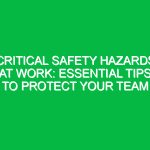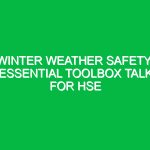Introduction
Hello team! Today, we are having a toolbox talk about an often-overlooked aspect of our work Environment: wildlife in the workplace. Whether you work in an office, a construction site, or an outdoor field, it’s crucial to understand how wildlife can affect our health, safety, and environment (HSE). This discussion will cover potential Hazards, best practices for interactions with wildlife, and how to maintain a safe workplace for everyone.
Understanding Wildlife in the Workplace
Wildlife refers to all living organisms that are not domesticated, including birds, insects, mammals, and reptiles. Interactions with wildlife can occur more frequently than we might expect, especially in areas where natural habitats overlap with human activities. Recognizing the presence of wildlife and understanding the potential risks associated with it is essential for maintaining a safe workplace.
Why is Wildlife a Concern?
Wildlife can pose various risks, including:
- Physical Hazards: Animals can cause injuries through bites, stings, or tripping hazards.
- Health Risks: Wildlife can transmit diseases through direct contact or contamination of surfaces and food sources.
- Environmental Impact: Disturbing wildlife can lead to ecological imbalances and damage to local habitats.
Real-Life Examples
Consider a construction site near a forest. Workers may encounter snakes, which can pose a danger through bites, or nests of bees, which can lead to allergic reactions. Alternatively, in an office setting, you may find birds nesting in ventilation systems, creating hazards due to potential falls or disease transmission. These scenarios highlight the importance of recognizing and managing wildlife interactions effectively.
Identifying Potential Hazards
Before we dive into Best Practices, let’s identify some specific wildlife-related hazards you might encounter:
- Rodents: Can carry diseases and contaminate food.
- Insects: Bees, wasps, and ticks can sting and transmit diseases.
- Large Animals: Deer, moose, or raccoons can cause vehicle accidents or physical injuries.
- Birds: Can create nests that block ventilation or lead to droppings that may harbor pathogens.
Best Practices for Safety
Understanding the risks is the first step; knowing how to manage them is essential. Here are some Best Practices to follow:
Awareness and Education
Stay informed about the types of wildlife in your area. Regularly participate in HSE Training that includes wildlife awareness. Understanding the behavior of local wildlife can help you anticipate potential encounters.
Reporting Wildlife Sightings
If you encounter wildlife on the job site, report it immediately to your supervisor or the HSE team. This allows them to assess the situation and take appropriate action to ensure Safety for all employees.
Maintain Clean Work Areas
Keeping your work environment clean is crucial. Dispose of food waste properly, store supplies securely, and avoid leaving items outside that may attract wildlife. A clean workspace minimizes the risk of attracting animals.
Use Caution and Stay Calm
If you encounter wildlife, remain calm and avoid sudden movements. Give the animal space to retreat. Most wildlife will avoid humans if given the opportunity. Do not attempt to touch or provoke the animal; this could lead to injury.
Utilize Personal Protective Equipment (PPE)
In some environments, wearing the right PPE can help protect against wildlife-related hazards. For example, sturdy boots can protect against snake bites, while gloves can prevent insect stings. Always assess the risks in your specific area and equip yourself accordingly.
Understanding Regulations and Company Policies
It’s essential to be aware of any relevant regulations or company policies concerning wildlife interactions. Many regions have laws protecting certain species, and it’s crucial to comply to avoid legal issues. Additionally, our company has specific guidelines regarding wildlife encounters that you should familiarize yourself with.
Legal Implications
Failing to adhere to wildlife regulations can result in legal penalties for the company and individuals involved. Always report wildlife incidents and follow established protocols to mitigate risks. This protects not only your safety but also the company’s reputation and legal standing.
Encouraging Open Dialogue
Engaging in open discussions about wildlife safety can foster a culture of safety within our workplace. Here are some questions to consider:
- Have you encountered wildlife during your work? How did you handle it?
- What additional measures do you think we can implement to enhance safety regarding wildlife?
- Are there any specific wildlife-related incidents you believe we should learn from?
Conclusion
To wrap up, understanding and managing wildlife in the workplace is crucial for ensuring our safety and the safety of our colleagues. By being aware of potential hazards, following best practices, and adhering to regulations, we can minimize risks associated with wildlife interactions. Thank you for your attention and your commitment to maintaining a safe and healthy work environment. Remember, safety is a shared responsibility, and your vigilance can make a significant difference.


